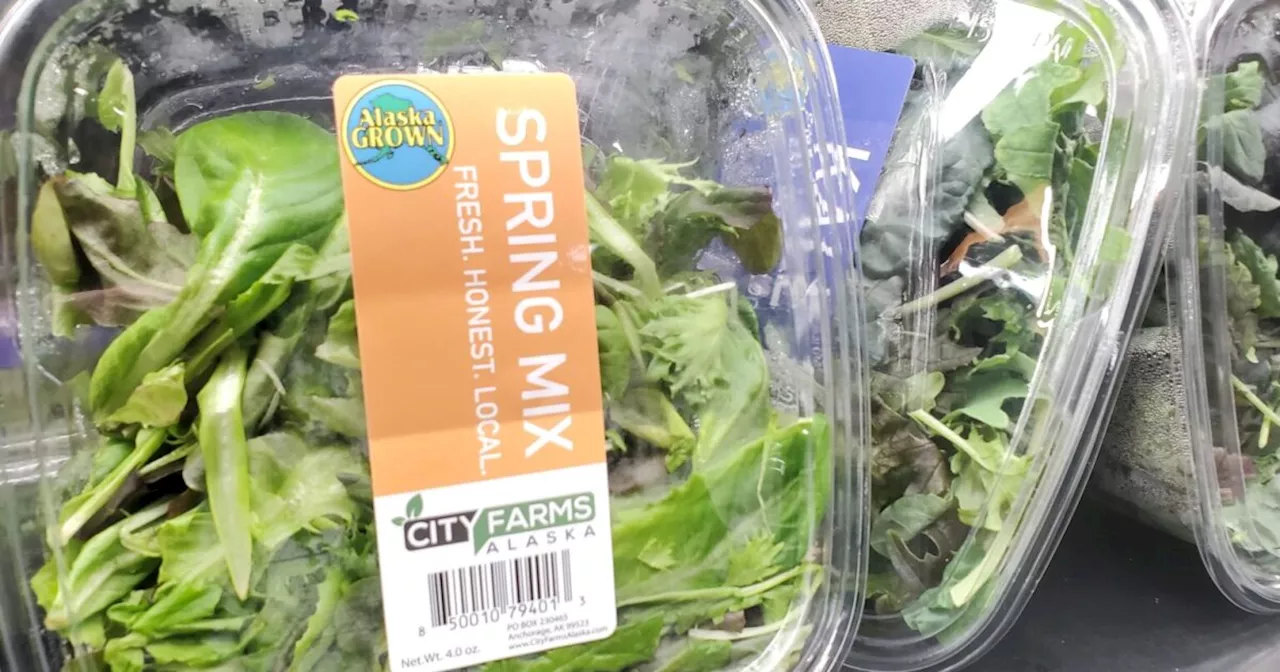A recent study reveals that Alaska grocery shoppers are willing to pay a premium for locally grown lettuce, particularly when informed about the benefits of supporting local agriculture. The study, conducted several years ago but deemed still relevant due to Alaska's unique geographical context, highlights the consumer preference for locally sourced food.
Alaska Grown -labeled salad greens are offered for sale on January 14, 2025, at Natural Pantry, a health food store in Anchorage. Grocery shoppers are willing to pay a premium for locally sourced lettuce, researchers have found - sometimes a significant premium, especially when they have information about the benefits of locally grown food. Alaska grocery shoppers on average were willing to pay $1.90 extra for a head of lettuce if it was labeled as “ Alaska Grown ,” the study found.
When given information about locally grown products’ benefits to health, the environment and the state economy, provided by products with the “Alaska Grown” label, that premium jumped to $3.31 on average. The study is based on surveys and interviews of shoppers at Anchorage grocery stores and farmers markets, led by Qiujie Zheng, an associate professor of business analytics at the University of Maine. Zheng was previously at UAA. While the surveys and interviews were conducted several years ago, in 2018, Zheng said she believes the results still stand. The COVID-19 pandemic that came later may have changed food consumption patterns worldwide, she said by email. “However, due to Alaska’s unique geographical location, I believe that the state’s agricultural supply and consumers’ fresh produce options have remained relatively stable over the past few years,” she said. She noted the Alaska Grown $5 Challenge program, a summer and fall campaign that encourages residents to spend at least $5 a week on locally grown food. The information the researchers used from the state has been consistent, she added. It was important to study consumer preferences for Alaska Grown products because the subject has gotten much less attention than consumer attitudes about local foods elsewhere, Zheng said. “Alaska’s unique geographical location significantly influences its food supply. Since the majority of Alaska’s food is imported, Alaska’s food supply is vulnerable to supply chain disruptions and natural disasters,” she said by email. “A stronger local food system could improve the resilience of the state’s food supply. Understanding consumers’ preferences for local foods and identifying potential marketing and communication strategies are critical before promoting local food in Alaska. This helps strengthen the local food network, and, in the long run, enhances the resilience of Alaska’s food supply.” The study also analyzed consumer preferences about lettuce labeled as organic and lettuce grown through hydroponics. Taken in isolation, the Alaska Grown premium that consumers were willing to pay was higher than that for organic food and for hydroponic-grown lettuce. Without being given extra information about benefits, consumers were willing to spend $1.74 more for organic lettuce and 73 cents more for hydroponic-grown lettuce. Consumer preferences were more complicated when the Alaska Grown, organic and hydroponic labels were combined and when additional information was provided, the study found
Food & Beverage LOCAL FOOD ALASKA GROWN CONSUMERS LETTUCE ORGANIC HYDROPONIC FOOD SUPPLY CHAIN FOOD RESILIENCE
United States Latest News, United States Headlines
Similar News:You can also read news stories similar to this one that we have collected from other news sources.
 Alaska College Hockey Teams Head to Tournaments in Lower 48Alaska Anchorage and Alaska Fairbanks will compete in tournaments this weekend.
Alaska College Hockey Teams Head to Tournaments in Lower 48Alaska Anchorage and Alaska Fairbanks will compete in tournaments this weekend.
Read more »
 Alaska Gasline Development Corp. in Secret Talks for Trans-Alaska PipelineThe Alaska Gasline Development Corp., a state-owned entity, announced it has entered into exclusive negotiations with an undisclosed energy company to lead and finance the development of a trans-Alaska natural gas pipeline. The project, estimated to cost at least $44 billion, has been a long-standing goal with significant cost as a major obstacle. The agreement includes plans for an export facility, indicating the project is for the larger, previously discussed pipeline.
Alaska Gasline Development Corp. in Secret Talks for Trans-Alaska PipelineThe Alaska Gasline Development Corp., a state-owned entity, announced it has entered into exclusive negotiations with an undisclosed energy company to lead and finance the development of a trans-Alaska natural gas pipeline. The project, estimated to cost at least $44 billion, has been a long-standing goal with significant cost as a major obstacle. The agreement includes plans for an export facility, indicating the project is for the larger, previously discussed pipeline.
Read more »
 ANILCA: Carter's Legacy in Alaska | Talk of AlaskaWe discuss President Carter's legacy of conservation, and the Alaska National Interest Lands Conservation Act on this Talk of Alaska.
ANILCA: Carter's Legacy in Alaska | Talk of AlaskaWe discuss President Carter's legacy of conservation, and the Alaska National Interest Lands Conservation Act on this Talk of Alaska.
Read more »
 Store Cards Beat Buy Now Pay Later for Most ShoppersA new LendingTree report reveals that a majority of shoppers prefer store cards over buy now, pay later (BNPL) options, particularly older generations. While BNPL is popular with younger demographics, concerns about long-term interest rates are driving some to choose store cards.
Store Cards Beat Buy Now Pay Later for Most ShoppersA new LendingTree report reveals that a majority of shoppers prefer store cards over buy now, pay later (BNPL) options, particularly older generations. While BNPL is popular with younger demographics, concerns about long-term interest rates are driving some to choose store cards.
Read more »
 Store Cards Preferred Over Buy Now, Pay Later by Most ShoppersA new report by LendingTree reveals that a majority of shoppers prefer store cards over buy now, pay later (BNPL) plans. This preference may indicate a desire for longer-term financial assistance. While BNPL is popular among younger generations, older demographics favor store credit cards.
Store Cards Preferred Over Buy Now, Pay Later by Most ShoppersA new report by LendingTree reveals that a majority of shoppers prefer store cards over buy now, pay later (BNPL) plans. This preference may indicate a desire for longer-term financial assistance. While BNPL is popular among younger generations, older demographics favor store credit cards.
Read more »
 Alaska Commission Proposes Biennial Pay Raises for State OfficialsThe State Officer Compensation Commission in Alaska is set to recommend biennial pay raises for state officials including the governor, lieutenant governor, department heads, and legislators. This proposal follows a recent 20% salary increase and aims to address concerns about the cost of living in Juneau.
Alaska Commission Proposes Biennial Pay Raises for State OfficialsThe State Officer Compensation Commission in Alaska is set to recommend biennial pay raises for state officials including the governor, lieutenant governor, department heads, and legislators. This proposal follows a recent 20% salary increase and aims to address concerns about the cost of living in Juneau.
Read more »
